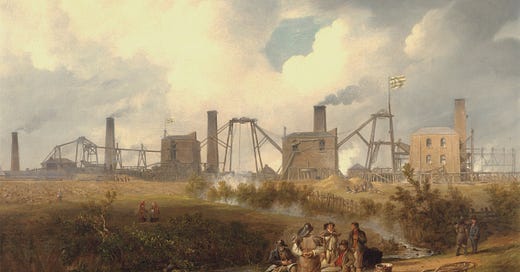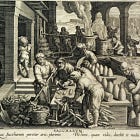A Framework For The Cyclical Industries
How to understand, model and find opportunities among the cyclicals.
Investing in cyclical industries is not the most prestigious field in the financial arena. These industries tend to have structural factors driving down their returns, are generally mature, and do not carry high multiples. They seem to attract only specialists.
However, a simple look at the stock price movement of many of these names, plotted against revenues or operating margins, reveals clear patterns of boom and boost, i.e., pricing inefficiencies. In my experience, cyclical names have provided great opportunities for contrarian investing on returns to the mean. Further, knowledge about cycles can be applied to many industries and, therefore, fits a generalist approach.
This article explores the characteristics of cyclical industries and their different types. It also explains a framework for evaluating cyclical companies as potential investments.
I have analyzed several cyclical industries, you can visit the primers below:
Sugar, spice, and everything nice: what creates a cyclical industry
Not all industries show cyclical characteristics. There are specific factors leading to some industries being cyclical and having different types of cycles. In this section we will learn about those characteristics
Information lags: From the systems theory perspective, cyclical patterns are generated by lags, delays, and other impeding factors in adjustment loops. Demand or supply do not respond quickly or in the right direction to the information transmitted by prices.
Barriers to supply adjustment: The most important characteristic for creating a cyclical industry is probably the existence of impediments to supply adjustment, to the upside or the downside. The more complex and lengthy the process for increasing or reducing supply, the longer the cycle period and the higher the cycle amplitude.
Barriers to entry: In some cases, it is difficult to bring new supply to the market, or it is difficult to make it quickly enough. This creates situations of under-supply, high margins, and high incentives to bring new supply to the market. The barriers to entry generate the upper portion of the cycle.
Fixed assets: The most common type of barrier to entry is fixed asset construction. Chemical, cement, or steel plants take time to build. They also generally cost a lot of money, potentially in the billions, meaning a complex decision process. This means that even if today there is a lack of a product, and the price paid for it is high, increasing its production will take time.
However, not all fixed assets work as barriers to entry. If the asset can be procured easily, fast, or cheaply, then there is no barrier. Agricultural land and airplanes can be easily leased (on the margin), and unconventional wells take very little to be brought to production.Other barriers: There are many other types of barriers, which we will analyze for each of the industries covered. For example, increasing the animal population (to produce more chicken or cow meat) can take a few years, just for biological reasons.
Eventually, all economic processes run into some limiting factor (land, resources, workers, etc.) that will make expanding production difficult, leading to a higher margin cycle.No barriers to entry: On the contrary, when there are no barriers to entry, the industry tends to be permanently unprofitable, with only some companies enjoying absolute cost advantages. These industries are not super cyclical but rather show long periods of bear market, punctuated by strong bull market spikes. We will see examples from agricultural commodities, unconventional hydrocarbons, and shipping.
Barriers to exit: Cycles also generally require barriers to exit; otherwise, supply would decrease quickly when excess occurs. Just as the barriers to entry generate the upper portion of the cycle, the barriers to exit generate and exacerbate the downward portion. Sometimes the barrier to exit does not mean that the company closes a plant, but also that it doesn’t lower production in the face of lower prices.
Sunken costs: The main barrier to exit in cyclical industries is that the fixed assets are already in place, and their value cannot be recovered, therefore, the owners prefer to continue producing at any price, to at least recover a portion of the costs. This extends the cycle, lengthening the exit of unprofitable production.
Volume dilution: In a related fashion, cyclical industries tend to have high fixed costs and low variable costs. For example, it costs about the same to fly a plane with 50 passengers as one with 200 passengers. This also incentivizes companies to prioritize volumes over profitability (lowering price to sell more), which also leads to excess supply.
Low barriers to exit: With low barriers to exit, excess production can be quickly eliminated, and therefore, depression periods last less. No industry has no barriers to exit, but in some cases is easier. An example is the gig-economy: when Uber prices are too low because there is no demand, some drivers decide not to work, and reduce supply.
The role of demand: Demand also plays a role in cycles. In some cases it is a fixed factor, that will not vary a lot, independently of how much supply there is, or how expensive it is. In other cases, demand is the volatile factor that causes the cycles.
Mature and inelastic demand: In most cyclical industries, demand is either relatively fixed or growing at a well-understood rate. Further, demand is relatively inelastic to price, meaning almost the same amount will be demanded at most prices. Of course, demand can adjust (say, people buying smaller cars if oil is expensive), but this takes time and is marginal compared to changes in supply.
Demand-driven cycles: In other industries, demand volatility is the main driver of the cycle. These industries still need some barriers to supply exit (otherwise, supply would adjust), but the main factor is always demand. The main driver of demand volatility is the macroeconomic cycle, mainly via disposable income. Some industries may also be affected by idiosyncratic factors like the inventory cycle or the fashion cycle.
The cyclical zoo: types of cyclical industries
We can apply the concepts above to specific industries below. It becomes clear that structural characteristics determine the cycles in these industries.
Semi-cyclical industries
The industries in this section are generally considered cyclical, but in my opinion, they are not really. They tend to have long bear markets, followed by short and explosive bull markets (this is what people generally call the cycle of these industries). The reason for this is that these industries have atomized producers, with low barriers to entry and exit and fixed demand, leading to a situation of general oversupply with a few periods of undersupply. These industries tend to have a few very low cost producers (generally because of natural factors) that can obtain rents, while the rest of the companies are barely profitable.
Grains: Staple grains (soybeans, wheat, corn) have super atomized producers. Entering the industry requires little capital, given that most land and machinery can be leased, and a relatively small production unit—perhaps just a few hundred hectares—is often sufficient. Unused land can be made productive in one season. Exiting is also easy, although there is an incentive to keep marginally productive lands occupied.
This leads to an almost permanent state of excess capacity, with some spurs to the upside every decade or so. In my opinion, these grain price peaks were more driven by inputs (oil via fertilizers and machinery, transport costs) than supply imbalances.
In this industry, the high-yield producers can be permanently profitable (for example, some land in Brazil and Argentina), but this is generally arbitraged away via the cost of land.
(Unconventional) oil: Oil used to be a hard-adjustment industry because most oil came from traditional onshore wells (moderate capital costs, producing for decades) and offshore platforms (high capital costs, several decades of production). This led to the classical cycle of over and undershoots in investment, followed by excess volume production.
However, things changed when unconventional production was introduced. The cost of drilling a single well is much lower, and these wells typically reach peak capacity and are exhausted much more quickly—often within just a few years. As a result, capacity can expand and contract much faster, leading to more moderate cycles but also to a more vicious and lengthy bear market (because marginal producers quickly increase production).
Just like in agriculture, rent factors (basin characteristics, transport infrastructure) determine the lowest cost to produce (the lifting cost, or all-in breakeven cost) and which producers and regions are (almost) permanently profitable.
Natural gas: The natural gas industry in unconventional fields has a similar supply structure to unconventional oil (supply can be adjusted fairly easily up and down). This already leads to a market that tends to be more oversupplied generally. In addition, two extra characteristics make natural gas bear markets even more prolonged and vicious than in oil. The first is that gas cannot be transported easily (LNG capacity is limited in many areas, and so is pipeline capacity, with trucking being cost-prohibitive), so demand is generally much more limited regionally. Second, gas can be a by-product of oil production (depending on the geology, a well will produce almost all oil, gas, or a mix), meaning that if oil is still profitable, its excess gas production will drive gas prices down.
Shipping a good example of sunken costs: Shipping companies tend to own and operate ships under contract with logistics companies. The barriers to entry are high (a Panamax can cost $40 million), which should lead to a more normal cycle.
However, the marginal cost of operating a ship is negligible, given that the lessor pays for the variable costs of crew and fuel. Most of the costs (D&A, G&A, docking, interest on debt) are fixed. Further, a docked ship generates docking costs (you cannot just park your Panamax anywhere). Finally, the resale value of a ship is not high during bear markets, and its scrap value is even lower.
This leads to a system where ship owners are incentivized to offer their ships at whatever price they can. Prices remain so depressed that almost no owner can repay its cost of capital (D&A and interest, not to talk of returns to equity), but still prefers to charter the ship than not to do it.
Only slowly capacity is removed from the industry by the end of the life of the ship hull (about 25/30 years). This, or some other disruption in supply chains, leads to a bull spike in prices that can easily go parabolic. During bull markets, animal spirits reign again, and a lot of new capacity is ordered.
High(er) barrier industries
In industries where the cost of capital per unit of production is higher or where economies of scale offer significant cost advantages, we tend to find the more traditional cyclical industries. Cycles tend to be long (it takes a long time to bring or remove capacity), and bulls can be as long as bears. Such industries often operate in a cost-plus model, where the companies make a margin on input costs, regardless of fluctuations in input or end-market prices. In this context, the cycles primarily reflect changes in processing margins.
Salmon farming: Salmon is an interesting industry, because its barriers to entry and exit were originally low. The industry should have been originally in the above section. However, its production reached global biological limits, generating enormous rents.
Adult salmon are raised in open-sea pens, which can only be situated in cold sea fjords found in a limited number of locations. Further, once a population limit is reached in a fjord, pests and diseases grow fast, so governments establish quotas. Most of the available space and capacity for salmon farming is already in use (mainly in Norway and Chile).
Unlike the grains market, this results in demand consistently exceeding supply, driving up profitability and allowing current producers to secure substantial and growing economic rents. This profitability led Norway to introduce a 25% resource VAT on salmon production in 2022.
Animal proteins: Opening a poultry, swine, or cattle-raising facility is a small capital commitment, meaning low barriers to entry. However, these industries have biological limitations in terms of supply expansion, which generates cycles.
When margins are good (price of live animal versus the cost to feed it using grain or pastures), producers expand their populations by sacrificing less females (hens, sows and heifers). The population expansion process takes months for poultry, a few years for swine, and several years for cattle. This means that supply takes time to adjust to demand. The opposite happens on the downside, with animal populations taking years to decrease.
Other factors affecting the cycle are the difficulty of transporting live animals, which creates regional bags of supply (producers) and demand (processors). Just like in grains, some producers have natural cost advantages (ex: being close to grain suppliers or having cheap pastures). In addition, pen-raised animal industries (mostly poultry and swine) present significant scale advantages, an incentive to invest in large fixed assets (another cyclical factor).
Meatpackers: Between protein end markets and the live animal, we have the meatpackers or meat processors. They buy the live animals, sacrifice them, and sell the meat. Some meatpackers also integrate the husbandry process. The meatpacker cycle is driven by the squeeze between end-market demand (mostly inelastic, with moving prices) and input costs (either grains for integrated or live animals for processors only). When there is wide availability of animals (or grains are cheap) and meat markets are normal, the processor makes a good margin. When animals are more scarce, the margin is lower.
The cost of entry in this industry is low because each processing plant is not huge. For the same reason, the cost of exit is also low, as a company with a few dozen plants can decide to turn a few on or off (and this is usual practice to benefit from region arbitrage). This would all lead to a not-very-profitable, perma-bear industry. However, the industry has large benefits to scale. The scale needed to operate profitably becomes a barrier to entry. One important factor is bargaining power with farmers (processors tend to constitute regional oligopolies). Another one is the ability to arbitrage the bags of supply/demand that form in different markets because of the difficulty of transporting live animals. Processors also benefit from scale to obtain export permits for different markets.
Bulk chemicals: Bulk chemicals (commoditized elements like simple hydrocarbon derivatives, salts, plastics, etc., in contrast to specialty chemicals) have huge scale advantages and high capital costs per plant (barriers to entry). They tend to have high fixed costs and low variable costs (barriers to exit). Demand is pretty mature, barring exceptional economic conditions. This all leads to very traditional cycles.
The cycle in the bulk chemicals industry is driven by processing capacity. When there is too much capacity, companies cannot make a high margin on top of their input costs. On the contrary, with low capacity, companies can make higher margins. The price of the final product or the inputs is not as important, as these industries tend to operate based on a cost-plus model (adding a markup to whatever the input cost is). It is this markup that cycles.
The integrated model (adding processing up or downstream, or expanding horizontally to similar compounds) is common among chemical companies, to absorb the processing margins of several stages, gain even more scale advantages, and arbitrage production between markets when possible.
Markets of cyclical demand
In some industries, the cycle is driven more by demand than supply. Still, because supply is relatively fixed, it cannot easily adjust to new demand, and its margins suffer. These industries include all consumer discretionary (also called consumer cyclical).
Cement: Although cement has high capital costs and is inflexible to reduce supply, the industry is quite protected by transportation costs, generating pockets of monopolies or oligopolies. This tends to lead to better margins and cyclicality that is not driven by supply but rather by end demand (construction, infrastructure). So, depending on the geographical market, cement can be a demand- or supply-driven cycle, or both, but with generally much better margins than other CAPEX-heavy industries.
Real estate: Capital barriers to entry in real estate are not super high (always dependent on the specific market), but expanding supply takes time. Barriers to exit are high, as tearing down the building doesn’t give anything back in return but land, leading to inflexible supply to the downside. This would lead to a supply-driven cycle.
However, it is more common to have demand-driven cycles, given that end demand for real estate moves much faster with the general economic cycle, at least in the margin. On the other hand, the real estate cycle is dampened by stacking leases, which means changes in occupation and rent/sqft take time to impact a whole portfolio.
Retailing: Retailing barriers to entry are low (depending on the category). Store space can be leased, and the labor force is not highly specialized. On the other hand, barriers to exit are a little higher (penalties for lease abandonment, severance, high fixed costs inducing volume selling). In addition, its demand is highly volatile. This leads to a demand-driven cycle.
Demand volatility can arise from the macrocycle (disposable income, etc.) or from idiosyncratic factors (vogues, the fashion cycle). With generally low margins and significant operational leverage (leases plus salaries and overhead are pretty fixed), the margin cycles in retailing can be brutal. Because retailers have high fixed costs, they generally engage in heavy discounting in an effort to increase volumes. This makes the downward cycle even more violent.
Discretionary brands: A lot of brands are so powerful that they are almost a monopoly. In this case, it makes no sense to talk of barriers to entry/exit (the barriers to entry are simply huge, so no one enters). Still, even these brands can suffer from demand cycles.
One factor generating demand volatility is the macro, obviously. Besides this, we also have the fashion cycle (explored in more detail in another article below). We can also comment on the inventory cycle: when sales are good, retailers order more from brands, to increase their inventories; when sales turn bad, the retailers have too much inventory, therefore leading to lower orders because of lower sales, but also because they accumulated inventories previously.
A framework for finding opportunities in cyclical
In this section, I explain a framework that has served me well in finding unloved cyclicals and holding them until the cycle improves, gaining from earnings and multiple expansion.
Given the amount of alternative data about cyclical markets and the periodicity of the cycles, it seems strange that this strategy has not been arbitraged out. It may not have a lot of capacity, particularly among emerging market names.
Others have explored the idea. For example, the famous Michael Burry one-pager. Peter Lynch also dedicated part of his books to cyclicals, following approximately the same framework. Finally, Edward Chancellor has a great book on cyclical industries called ‘Capital Returns’.
Simple explanation: The strategy is about buying companies when they trade well below their average earnings capacity for cyclical reasons and holding until the cycle recovers, without trying to time the cycle. The framework requires selecting some specific companies where this strategy can work. The main factor we are filtering for is survival ability. For the strategy to work, it has to survive a down-cycle of unknown length and deepness. The more characteristics a company ticks, the better the setup.
Lookback period: The first we have to check is if the name has enough cycles to be able to think about what happened in the past. A few cycles can be sufficient, and whether that’s 5, 10 years or 20 years depends on the industry.
Profitable during all (or most) cycles: This is probably the most important characteristic. The company has to have positive operating income during all of the previous cycles. Some exceptions can be made for super-bears, like negative oil during COVID-19 or some building industries during the GFC, and we should adjust for non-cash factors like impairment. If the company recurrently has negative margins during bears, it is not a good option because it may not survive the next bear.
Profitability during all cycles is also key to determining that a company is not the marginal producer in the market and, therefore, it is not the one that will close capacity at the bottom of the cycle. Profitability across cycles is also an indicator of other positive characteristics (good management, low-cost position, good capital allocation, operational efficiencies, etc.)
Manageable debt: If the company doesn’t have debt, that’s a great scenario. In these industries, returns on assets are not great, so unless the debt is very cheap and fixed, it doesn’t make a lot of sense (indicating bad capital allocation from management if the company has it). If the company has cash, that’s even better because of counter-cyclical capital allocation (below).
Still, this does not mean that debt is unacceptable. Low and fixed rates with maturities of more than five years are ok. In all cases, debt interest must be easily covered with operating or EBITDA minus maintenance CAPEX income, even during bears. A company that may not cover interest with EBITDA during a bear is a ticking bomb.
Counter-cyclical capital allocation: Bonus points for this one (or negative points if capital allocation is super cyclical). Bear cycles are great opportunities to buy assets from distressed competitors at lower valuations. This is the time to deploy CAPEX for the next cycle. On the contrary, the company should return capital or hoard cash during bull markets.
It is not terrible if the company has cyclical capital allocation because these are not buy-and-hold investments, so I am not as concerned with super managerial quality.
Estimating average earnings: The bulk of the idea is to buy something when it is trading at a deep discount to cycle-average earnings, but estimating those earnings is not straightforward for all companies. Many factors have to be considered. Depending on the information available, a more complex model (good separation of variable and fixed margins, good modeling of revenues, etc.) or a simpler model (average operating margins) can be used.
Adjust for capacity: during previous cycles, the company may have had less production capacity (i.e., fewer factories, square meters of renting space, stores, hectares under agriculture, etc.). We need to find some ideas for unit economics.
Adjust for fixed cost structure: The company's overhead will not move through the cycle, so we should try to understand how big that portion of costs is. This includes interest expenses. Then, we can model volatile margins or revenues for the variable portion and remove the fixed costs.
Proxy via margins: Sometimes, we can proxy the variable unit economics using gross or variable-cost margins. If that’s not possible, we can proxy using the operating margin across the cycle, and applying that to cycle-average revenues.
Cycle-average revenues: Using average margins also requires forecasting average revenues. This may be straightforward if revenues drive margins, but it may not be as easy in a process industry, where revenue is (more) independent of margins and volumes.
Proxy via scenarios: On other occasions, we can think of scenarios. For example, oil went from $40 to $120 between 2020 and 2022, so this period gives us two good extreme points. Adjusting for capacity, we could use those two as limits, and think of the average as something in between.
Structural changes: Are the previous cycles not applicable for some reason? Examples might be a lot of new capacity leading to more violent downturns, or a structural change to demand. The key word is structural, because during bears there are always reasons to be bearish, so the change has to be very significant.
A good hurdle rate: This framework is risky. The bear market in the industry might last a lot, or the company might suddenly be underpriced and become the marginal producer, leaving the market. Debt might become unmanageable. The controlling shareholders (very common in these industries) might tender the minority at low cyclical prices. Therefore, the hurdle rate (in my opinion, the yield surging from cycle-average earnings over the stock price) has to be really good. In my case, I go for a 20/30% earnings yield. If there is any gain from stock appreciation, then better, but I do not consider any multiple expansion (in fact, by not considering stock appreciation with earnings growth, I implicitly think of multiple contraction). If the cycle average yield is 10%, then it doesn’t pay for the risk, IMHO.
Conclusions
Surprisingly, given the maturity of the industries, and the periodicity of the cycles, cyclical stocks still go up and down following (or sometimes a little in advance) of their industry cycles. This provides opportunity to profit from earnings and multiple expansion.
Doing that requires having a framework for evaluating company survivability, and for thinking about the drivers of the cycle, without becoming an industry expert. It is not a framework exempt from risk, but I would argue that in many respects the uncertainty is lower than in forecasting earnings growth one decade ahead.
Hope that you liked this article, and as always, giving it a like and sharing it help me a lot in reaching more people. Cheers!
Disclaimer: The opinions expressed in the Blog are for general informational purposes only and are not intended to provide specific advice or recommendations for any individual or on any specific security or investment product.











Amazing write up thanks!